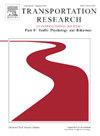穿越交通障碍:阿肯色州老年人对新出行选择的熟悉程度以及对自动驾驶汽车的看法
IF 3.5
2区 工程技术
Q1 PSYCHOLOGY, APPLIED
Transportation Research Part F-Traffic Psychology and Behaviour
Pub Date : 2025-04-30
DOI:10.1016/j.trf.2025.04.024
引用次数: 0
摘要
本研究的目的是分析老年人对新的交通选择(叫车服务、共享单车服务和共享电动滑板车服务)的熟悉程度,以及他们对自动驾驶汽车(全自动驾驶汽车)的看法,以及交通障碍如何影响他们的熟悉程度和看法,阿肯色州以农村为主。研究人员在2021年10月至2022年10月期间收集了775名60岁或以上的老年人的数据。为了实现研究目标,该研究使用了潜在类别聚类分析,根据老年人对新交通选择的熟悉程度和对自动驾驶汽车的看法,将老年人划分为不同的类别。采用结构方程模型分析了运输障碍对班级成员的影响。潜在类别聚类分析(LCCA)根据老年人对新出行服务的熟悉程度和对自动驾驶汽车(AVs)的看法,确定了三个不同的老年人群体。第一组是不熟悉的老年人,他们对新的交通方式不熟悉,对自动驾驶汽车持负面看法。他们更有可能遇到个人层面的障碍,包括行动障碍、停止驾驶和缺乏智能手机。第二组是“认识有负面看法的老年人”,他们知道叫车、汽车共享和微移动服务,但对自动驾驶汽车仍持怀疑态度。他们主要面临人际和社区层面的障碍,如缺乏非正式的乘车方式、出租车使用受限以及社会支持受限。第三组,熟悉的老年人与积极的看法,是最熟悉的新的移动选择,并表现出良好的态度,对自动驾驶汽车。然而,他们面临着汽车通行的限制和环境障碍,例如有限的公共交通和不足的行人基础设施。这些发现强调了有针对性的干预、技术培训、基础设施改善和政策举措的重要性,以提高老年人对新交通选择的熟悉程度和对自动驾驶汽车的接受程度。本文章由计算机程序翻译,如有差异,请以英文原文为准。
Navigating transportation barriers: Older adults’ familiarity with new mobility options and perceptions toward autonomous vehicles in Arkansas
The objective of this study is to analyze older adults’ familiarity with new transportation options (ride-hailing services, bike-share services, and shared e-scooter services) and their perception towards autonomous vehicles (fully autonomous cars), as well as how transportation barriers influence their familiarity and perceptions, in Arkansas, a predominantly rural state. Data from 775 older adults aged 60 years or older were collected between October 2021 and October 2022. To fulfill the study objective, the study used Latent Class Cluster Analysis to segment older adults into classes based on their familiarity with new transportation options and their perceptions of autonomous vehicles. The effects of transportation barriers on class membership were analyzed by employing a Structural Equation Model. The Latent Class Cluster Analysis (LCCA) identified three distinct groups of older adults based on their familiarity with new mobility services and perceptions of autonomous vehicles (AVs). The first group, Unacquainted Older Adults with Negative Perceptions, lacked familiarity with new transportation options and held negative views on AVs. They were more likely to experience individual-level barriers, including mobility impairments, driving cessation, and lack of smartphone access. The second group, Acquainted Older Adults with Negative Perceptions, was aware of ride-hailing, car-sharing, and micromobility services but remained skeptical about AVs. They primarily faced interpersonal and community-level barriers, such as lack of informal rides, limited taxi access, and social support constraints. The third group, Acquainted Older Adults with Positive Perceptions, was the most familiar with new mobility options and exhibited a favorable attitude toward AVs. However, they faced car access limitations and environmental barriers, such as limited public transit and inadequate pedestrian infrastructure. These findings underscore the importance of targeted interventions, technology training, infrastructure improvements, and policy initiatives to enhance familiarity with new transportation options among older adults’ mobility and acceptance of AVs.
求助全文
通过发布文献求助,成功后即可免费获取论文全文。
去求助
来源期刊
CiteScore
7.60
自引率
14.60%
发文量
239
审稿时长
71 days
期刊介绍:
Transportation Research Part F: Traffic Psychology and Behaviour focuses on the behavioural and psychological aspects of traffic and transport. The aim of the journal is to enhance theory development, improve the quality of empirical studies and to stimulate the application of research findings in practice. TRF provides a focus and a means of communication for the considerable amount of research activities that are now being carried out in this field. The journal provides a forum for transportation researchers, psychologists, ergonomists, engineers and policy-makers with an interest in traffic and transport psychology.

 求助内容:
求助内容: 应助结果提醒方式:
应助结果提醒方式:


